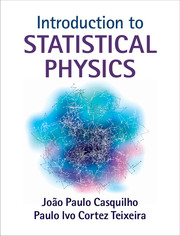Book contents
- Frontmatter
- Dedication
- Contents
- Preface
- Acknowledgements
- 1 Random walks
- 2 Review of thermodynamics
- 3 The postulates of statistical physics. Thermodynamic equilibrium
- 4 Statistical thermodynamics: developments and applications
- 5 The classical ideal gas
- 6 The quantum ideal gas
- 7 Magnetism
- 8 The Ising model
- 9 Liquid crystals
- 10 Phase transitions and critical phenomena
- 11 Irreversible processes
- Appendix A Values of some fundamental physical constants
- Appendix B Some useful unit conversions
- Index
- References
5 - The classical ideal gas
Published online by Cambridge University Press: 18 December 2014
- Frontmatter
- Dedication
- Contents
- Preface
- Acknowledgements
- 1 Random walks
- 2 Review of thermodynamics
- 3 The postulates of statistical physics. Thermodynamic equilibrium
- 4 Statistical thermodynamics: developments and applications
- 5 The classical ideal gas
- 6 The quantum ideal gas
- 7 Magnetism
- 8 The Ising model
- 9 Liquid crystals
- 10 Phase transitions and critical phenomena
- 11 Irreversible processes
- Appendix A Values of some fundamental physical constants
- Appendix B Some useful unit conversions
- Index
- References
Summary
Introduction
We can think of a gas as a fluid whose particles move fairly freely in space. The ideal or perfect gas is a limiting behaviour of a real gas, in which the interactions between particles are neglected. This approximation is valid when the potential energy of interaction between particles is negligible compared with their kinetic energy of motion. In some physical situations a real gas can be well described as an ideal gas. Fortunately, this is often the case with common gases under standard conditions for temperature and pressure; otherwise, evaluating the partition function of a real gas can become a formidable task. In the last section of this chapter we will address the statistical description of a real gas. This turns out to be necessary when we want to study phase transitions. In this chapter we shall restrict ourselves to the one-component gas.
As we saw from solid-state physics examples in the preceding chapter, evaluating statistical quantities is relatively easy for ideal systems consisting of localised, non-interacting particles. By non-interacting particles or subsystems we implicitly mean ‘weakly interacting’, so that thermal equilibrium is maintained by energy exchange, as discussed before. An ideal gas, however, is a system of non-interacting and non-localised particles. In a quantum mechanical description of the one-component gas, the particles are identical and indistinguishable, as we shall see in the next chapter. However, in a classical description the particles are considered identical and distinguishable: think of the molecules of a gas being labelled 1,2, …, N. Thus the classical and the quantum statistical descriptions of the gas are different, and important consequences arise, namely that some classical thermodynamics results are inconsistent. In this chapter we shall give a ‘corrected’ classical description of the ideal gas to take into account that the molecules are indeed indistinguishable.
- Type
- Chapter
- Information
- Introduction to Statistical Physics , pp. 116 - 148Publisher: Cambridge University PressPrint publication year: 2014



